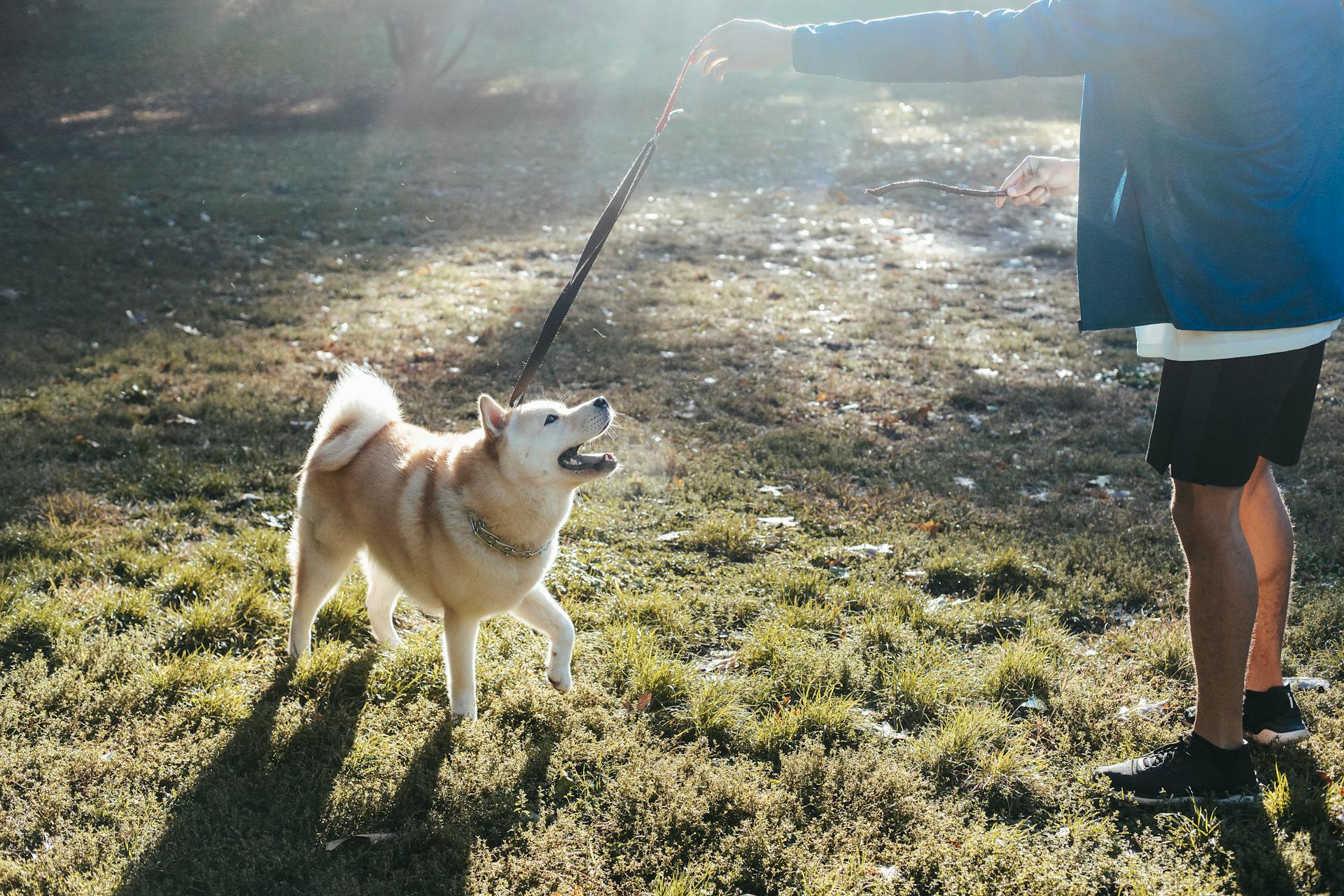
Conditioned emotional response dog training is a science-based approach that helps dogs associate certain emotions with specific situations or stimuli. This approach is based on the principles of classical conditioning, a concept developed by Ivan Pavlov.
By understanding how dogs learn and process emotions, you can use this method to train your dog to respond calmly and confidently in a variety of situations. For example, you can use a calm and assertive tone of voice to help your dog associate a positive emotion with a specific command.
Classical conditioning is a powerful tool for dog training, and it's been used successfully in a variety of contexts, from obedience training to addressing behavioral issues. By using this approach, you can help your dog develop a more positive and resilient emotional state.
Intriguing read: Reward Based Dog Training
What Is Classical Conditioning?
Classical conditioning is a process where an animal or person learns to associate two stimuli. The first stimulus is called the unconditioned stimulus (US), and it naturally causes the desired response.
The second stimulus is called the conditioned stimulus (CS), and it's paired with the US until the animal or person learns to respond to the CS alone. This means that after a while, the CS can elicit the desired response without needing the US.
For example, if you always feed your dog after they come inside from playing in the yard, they will likely start to associate coming inside with getting food. This is a simplistic example of the learning process, but it illustrates the basic principle of classical conditioning.
Classical conditioning is what helps dogs learn to feel happy and excited when they come inside, simply because they know they will get a meal. It's not just about the physical actions, but about the associations that are made in the dog's mind.
In classical conditioning, the presence of one stimulus causes the other to occur, which is why pairing two things together often enough can lead to a strong association. This is a fundamental concept that underlies many dog training techniques.
Recommended read: Will Neutering a Dog Stop Aggression
How it Works
Classical conditioning is a powerful tool in dog training that helps us understand how our furry friends learn and respond to different stimuli. The key to classical conditioning is that it takes advantage of our brains' ability to predict what will happen next, known as anticipatory learning.
Our brains are wired to find patterns and predict what will happen next, and this is why classical conditioning works so well. For example, Pavlov's original experiments with dogs showed that they learned to associate the sound of a bell with food, and would start drooling in anticipation of the food.
This process of classical conditioning involves pairing an unconditioned stimulus (US) with a conditioned stimulus (CS) until the animal learns to respond to the CS alone. The US is a stimulus that naturally causes a response, while the CS is a stimulus that is paired with the US to elicit a response.
Take a look at this: Medical Response Dog
Here's a simple breakdown of the classical conditioning process:
By understanding how classical conditioning works, we can use it to train our dogs to respond to different stimuli in a positive way. For example, if we always feed our dog after they come inside from playing in the yard, they will learn to associate coming inside with getting food.
A fresh viewpoint: Inside Dog Training
Training with Classical Conditioning
Classical conditioning is a powerful tool for changing your dog's emotional responses to various stimuli. It's a process where your dog learns to associate two stimuli, and eventually, the presence of one will cause the other to occur.
By pairing a neutral stimulus with an unconditioned stimulus (US) that naturally causes a desired response, you can create a conditioned stimulus (CS) that elicits the same response. For example, if you always feed your dog after they come inside from playing in the yard, they'll likely start to associate coming inside with getting food.
The goal of classical conditioning is to create a positive association between a stimulus and a desired response, making it a great way to address issues like separation anxiety or decreasing aggression. It's not about teaching your dog to perform a specific behavior, but rather about changing their emotional response to a particular stimulus.
Here are some examples of ways to incorporate classical conditioning into your training:
- Separation anxiety
- Decreasing aggression, fear, or reactivity to other dogs or people
- Working through stressful situations like vet exams, grooming, or everyday life
- Habituation to hardware like harnesses or muzzles
- Helping a dog feel confident in new environments by associating pleasant things with them
- Early socialization efforts with puppies
- Bonding
- Teaching a dog the meanings of words
- Building a positive association with their name
- Avoidant behaviors
Remember, classical conditioning can take time, and it's essential to take it slow and not push your dog too hard. If you notice your dog becoming sensitized or not making progress, it's best to take a break and consult with a professional.
You might like: It's Your Choice Dog Training
Understanding the Process
Classical conditioning is always happening, whether we want it to or not. It's a natural process that occurs in all environments on Earth, and we can't stop it from happening, but we can direct it.
Desensitization and counterconditioning are key components of conditioned emotional response dog training. This process involves changing the emotional response to a specific trigger, making the pet feel more comfortable. By practicing desensitization and counterconditioning at least twice weekly, you can help your dog overcome fears and anxieties.
You might enjoy: Desensitization Dog Training
A typical session might last anywhere from 5 minutes to 45 minutes, and it's essential to end on a positive note. Watch for signs that your pet is distressed, such as panting, trying to escape, trembling, barking, or becoming excited, and end the session immediately.
Here's a step-by-step guide to setting up a desensitization and counterconditioning session:
- Identify the "stimulus" (e.g., a bicycle passing).
- Identify the desired behavior (e.g., sitting).
- Identify something that prompts a happy emotional response (e.g., tiny, delicious treats, like hot dog pieces).
- Manage the intensity of the stimulus for desensitization.
By following these steps and gradually increasing the intensity of the exposure to the stimulus, you can help your dog overcome their fears and anxieties.
What Does a Session Look Like?
A desensitization and counterconditioning session is a process of helping your pet overcome a fear or anxiety by gradually exposing them to the stimulus that triggers the reaction. This process should be practiced at least twice a week, with daily sessions being even more effective.
The session should not be stressful, and it's essential to end on a positive note. Signs of distress in your pet include panting, trying to escape, trembling, barking, or becoming excited. If you notice any of these signs, it's crucial to end the session immediately and lower the intensity of the stimulus for the next session.
Intriguing read: Signs of Prey Drive in Dogs
The intensity of the stimulus can be controlled to prevent an intense reaction. For example, if your dog is afraid of bicycles, you can manage the distance and speed of the bicycle to prevent an intense reaction. This allows you to gradually increase the intensity of the stimulus over time.
Here's an example of how to set up a session for a dog that is afraid of bicycles:
- Start at a non-stressful or non-reactive point, such as standing 100 feet away from a bicycle that is not moving.
- Feed treats to pair the presence of the bicycle with a positive emotion.
- If your dog is comfortable and eating consistently, ask for a behavior such as sit and reward your dog for sitting 100 feet from the bicycle.
A sample progression for a desensitization and counterconditioning session for a dog afraid of bicycles might look like this:
- Stand far from a bicycle that is not moving.
- Gradually move closer to the stationary bicycle.
- Stand far away from a bicycle that is moving slowly.
- Gradually move closer to the slow-moving bicycle.
Continue this pattern until your dog is easily able to sit for treats, even when sitting close to a bicycle that is moving at full speed.
Behavior Modification
Behavior modification is the process of changing the way an animal behaves. This can be achieved by changing the emotional response to specific triggers, making the pet feel more comfortable.
The goal of behavior modification is to change the pet's response to triggers, not to suppress or mask the behavior. This approach helps to address the underlying issue, rather than just treating the symptoms.
On a similar theme: Dog Behaviour Modification
By changing the emotional response, behavior modification can help pets feel more at ease in situations that previously caused anxiety or stress. This can be especially helpful for pets that have developed behavioral concerns due to past experiences.
Behavior modification can be used to address a range of behavioral concerns, from separation anxiety to noise phobias. It's a versatile approach that can be tailored to meet the individual needs of each pet.
Expand your knowledge: Behavior Modification Dog Training
It's Always Happening!
Classical conditioning is happening all around us, all the time. It's a natural process that can't be stopped, but it can be directed.
You're constantly being bombarded with new stimuli and experiencing classical conditioning every day. For example, seeing a McDonald's sign might make you happy because you associate it with the taste of a Big Mac.
Classical conditioning occurs naturally in all environments on Earth, so it's everywhere. You can't stop it from happening, but you can influence how your brain responds to different stimuli.
Readers also liked: Operant Conditioning Dog Training

Here's a quick rundown of how classical conditioning works:
Remember, classical conditioning changes emotions, not actions. This means you can't reinforce or punish feelings like fear directly. However, you can manipulate fearful emotions by reinforcing enjoyable actions in the presence of scary stimuli.
For example, if your dog is afraid of bicycles, you can start by standing far away from a stationary bicycle and rewarding your dog with treats. Gradually increase the intensity of the exposure by moving closer to the bicycle or having it move slowly.
Sources
- https://vcahospitals.com/know-your-pet/introduction-to-desensitization-and-counterconditioning
- https://www.whole-dog-journal.com/training/counter-conditioning-and-desensitization-ccd/
- https://www.doggoneproblems.com/kenzie-anxious-dog-cer/
- https://kimpikespositivepaws.wordpress.com/tag/conditioned-emotional-response/
- https://www.simpawtico-training.com/classical-conditioning-in-dog-training/
Featured Images: pexels.com


